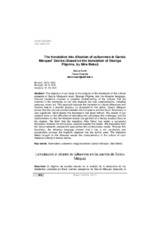The translation into Albanian of culturemes in García Márquez’ Stories (Based on the translation of Strange Pilgrims, by Mira Meksi)
La traducción al albanés de culturemas en los cuentos de García Márquez
Autor
Nushi, Admira
Editor
UCOPressFecha
2023Materia
TranslationCultureme
Magical realism
García Márquez
Mira Meksi
Traducción
Culturema
Realismo mágico
METS:
Mostrar el registro METSPREMIS:
Mostrar el registro PREMISMetadatos
Mostrar el registro completo del ítemResumen
The objective of our study is the analysis of the translation of the cultural elements of García Márquez’s book, Strange Pilgrims, into the Albanian language. Cultural translation requires a complete understanding of the cultures that are involved in the exchange, so not only linguistic but also communicative, including gestures, rituals, etc. This approach exposes the translator to cultural differences and involves him in a transfer process, as illustrated in this article. García Márquez proves that the cultural contrast between the Europeans and the South Americans is very significant, which makes the translator's task more difficult. The results of our analysis show us the difficulties of translating the culturemes, the challenges, and the achievements so that the Albanian reader can get hold of a literary creation close to the original. We think that the translator Mira Meksi has made a successful translation, towards the arrival pole, oriented towards the reader. The translation from the lexical-semantic perspective approaches the contemporary reader. Through this translation, the Albanian language showed that it has a rich vocabulary and successfully conveys the linguistic registers that the author used. The translator Meksi brought to the Albanian reader the characteristics of the culture of Latin American identity in twelve stories. El objetivo de nuestro estudio es el análisis de la traducción de los elementos culturales en Doce cuentos peregrinos de García Márquez traducido al albanés. La traducción cultural requiere una comprensión completa de las culturas que están involucradas en el intercambio, no solo lingüística sino también comunicativa, incluidos gestos, rituales, etc. Este enfoque expone al traductor a las diferencias culturales y lo involucra en un proceso de transferencia, como se ilustra en este artículo. García Márquez mismo comprueba que el contraste cultural entre los europeos y sudamericanos es muy significativo, lo que dificulta la tarea del traductor. Los resultados de nuestro análisis nos demuestran las dificultades de la traducción de los culturemas, los desafíos y los logros, para que el lector albanés pueda leer una creación literaria cercana al original. En nuestro análisis la traductora Meksi ha hecho una traducción exitosa hacia el polo de llegada, orientada hacia el lector. La traducción desde la perspectiva léxico –semántica se acerca al lector contemporáneo. Mediante esta traducción, la lengua albanesa mostró que tiene un léxico rico, y pudo representar los registros lingüísticos que el autor usa en los cuentos. La traductora Meksi representó ante los lectores albaneses las características de la cultura de Hispanoamérica en doce cuentos.

